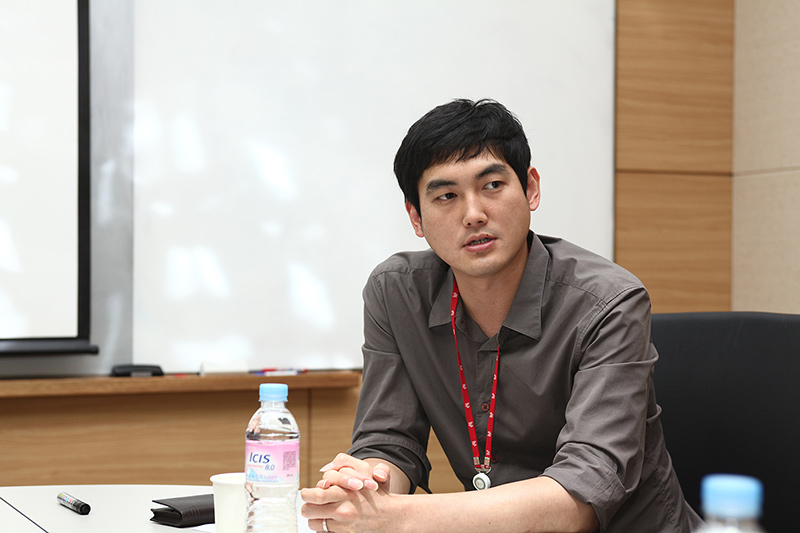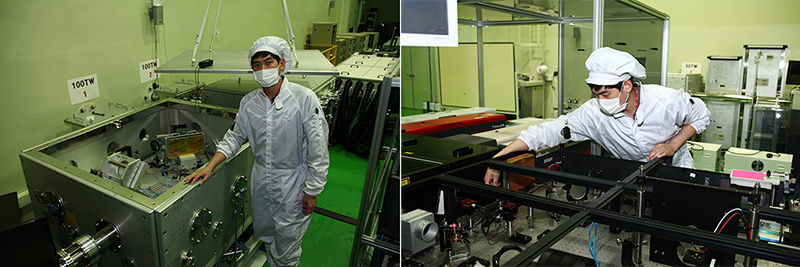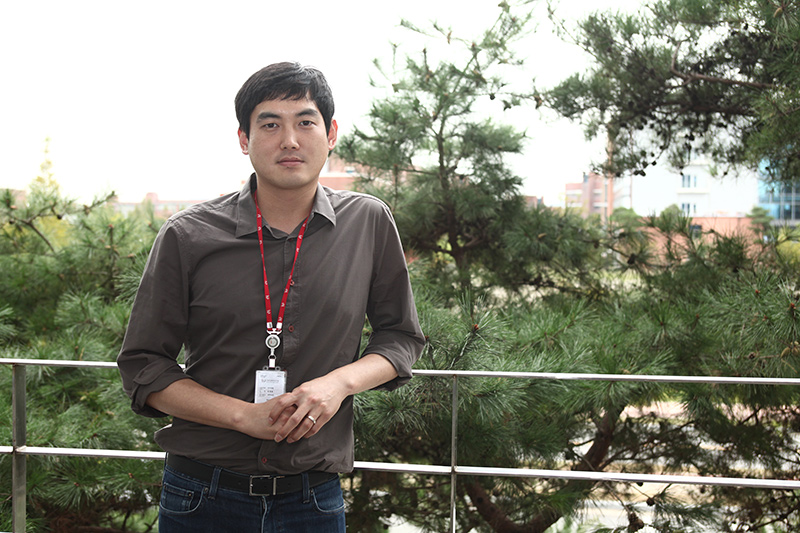주메뉴
- About IBS 연구원소개
-
Research Centers
연구단소개
- Research Outcomes
- Mathematics
- Physics
- Center for Theoretical Physics of the Universe(Particle Theory and Cosmology Group)
- Center for Theoretical Physics of the Universe(Cosmology, Gravity and Astroparticle Physics Group)
- Center for Exotic Nuclear Studies
- Center for Artificial Low Dimensional Electronic Systems
- Center for Underground Physics
- Center for Axion and Precision Physics Research
- Center for Theoretical Physics of Complex Systems
- Center for Quantum Nanoscience
- Center for Van der Waals Quantum Solids
- Chemistry
- Life Sciences
- Earth Science
- Interdisciplinary
- Institutes
- Korea Virus Research Institute
- News Center 뉴스 센터
- Career 인재초빙
- Living in Korea IBS School-UST
- IBS School 윤리경영


주메뉴
- About IBS
-
Research Centers
- Research Outcomes
- Mathematics
- Physics
- Center for Theoretical Physics of the Universe(Particle Theory and Cosmology Group)
- Center for Theoretical Physics of the Universe(Cosmology, Gravity and Astroparticle Physics Group)
- Center for Exotic Nuclear Studies
- Center for Artificial Low Dimensional Electronic Systems
- Center for Underground Physics
- Center for Axion and Precision Physics Research
- Center for Theoretical Physics of Complex Systems
- Center for Quantum Nanoscience
- Center for Van der Waals Quantum Solids
- Chemistry
- Life Sciences
- Earth Science
- Interdisciplinary
- Institutes
- Korea Virus Research Institute
- News Center
- Career
- Living in Korea
- IBS School
News Center
| Title | Helping the Development of the Laser with the World's Highest Power, 4 Petawatts (PW) | ||||
|---|---|---|---|---|---|
| Name | Department of Communications | Registration Date | 2016-10-26 | Hits | 7179 |
| att. |
 thumb.jpg
thumb.jpg
|
||||
Helping the Development of the Laser with the World's Highest Power, 4 Petawatts (PW)- YOO Je Yoon, Research Fellow of the Center for Relativistic Laser Science (CoReLS) -
Interview PreviewQ: You took part in developing the powerful laser capable of attaining a 4-PW laser pulse. Could you tell me how powerful this laser is when compared to lasers under development by other world-class institutes? Q: When did you join the Center for Relativistic Laser Science (CoReLS) at IBS? In 2012, researchers at CoReLS succeeded in generating laser pulses yielding a peak power of about 1.5 PW, the world's highest values ever achieved from the Ti:sapphire laser system. This year news reached us of the same researchers' upgrading the PW beamline to a 4 PW laser, almost three times higher than the previous power, in addition to another splendid feat of achieving laser pulses even with sub-20 fs duration which used to be measured at 30 fs. Delivering light with such ultra-intense power and ultrashort pulse, the culmination of cutting-edge technology, has been made possible by the Laser Development Team of CoReLS at IBS. IBS Newsletter met Yoo Je Yoon, a young promising physicist from CoReLS and spoke about ultra-intense laser development and his own story. Achieving high-power lasers by addressing two major determinants of the laser power"I had my most dramatic moment at CoReLS when we succeeded in amplifying a 4 PW laser for the first time. The entire crew of the Laser Development Team did not even think about getting off work because we were really immersed in conducting amplification experiments at the laboratory. We continued to make a gradual progress but were really cautious throughout the amplification progress, fretting at the slightest chances of going wrong until the output power of 4 PW was achieved late at night. All the members of the Laser Development Team had such hard times for a long time, and it was the very moment when we finally received rewards for our endeavors." said Research Fellow Yoo, recalling February of 2016 when the laser developed by his team delivered a 4 PW performance for the first time. Then, would you like to grasp just how powerful these 4 PW are? The incoming solar radiation at the outer border of the atmosphere is said to represent around 174 PW, so 4 PW is approximately worth of one fortieth of the solar energy falling onto the top of the Earth's atmosphere. Yoo explains that the intensity of light acquired from focusing this class of PW laser to 2μm (micrometer, 10-6m) in diameter by using a lens is equal to that of the collected sunlight in a circle of 15μm in diameter, 35 times smaller than the 0.5mm lead of mechanical pencil by using a lens size of the Earth. According to his explanation, compression allowing energy of the laser to be delivered within an extremely short time can result in the generation of massive power. The laser developed by the CoReLS emits ultrashort pulses of less than 20 fs, the time taken for the light to go to 6μm, a tenth of just a strand of hair. Given that light can travel around the Earth 7 and a half times in one second, it is a fleeting period of time. That is why an ultrashort pulse laser, generally of the order of femtoseconds, plays a critical role in exploring the microscopic world where molecular movement and electron scattering within matters are of interest. Therefore, we can be sure of the high demand for ultra-intense lasers throughout the world. Nowadays attempts have been made to realize high peak powers of 10 PW in laser development by European nations and China. The laser developed by the CoReLS yields a peak power of 4 PW, the highest in the world to date when actual availability comes into consideration in evaluating all kinds of lasers. Then, how was the CoReLS able to achieve the world's highest power for laser? According to Yoo's explanation, there are two factors: One is duration of laser pulses (pulse width) and the other is the energy of laser pulses. The power of a laser is the energy of the laser's pulse divided by the pulsewidth. Therefore, raising laser powers requires reduction of the pulse width or increase in energy, and the research center succeeded in improvements in both aspects. To reduce the pulse width of laser pulses, the wavelength area of the light should be expanded, which means having a broadband spectrum. Until last year, the pulsewidth of the CoReLS laser was 30fs, achievable by using a spectrum covering a range from 750 to 850nm (nanometer, 10-9m). Generating pulse duration of 20 fs called for spectrum enlargement from 740 to 860nm, just 10nm longer from the each end, but this process is considerably complicated. The laser spectrum continues to change during amplification. For example, amplification performance varies depending on wavelengths. As the spectrum of the seed beam initially generated goes through changes during amplification, optimization of spectrum through active modulation at the front-end part of the laser is really important to obtain a desirable spectrum after final amplification. To do so, the CoReLS developed their own technology of spectrum modulation. The CoReLS's achievements include provision of the energy required to support high energy short pulses. As high-power lasers are subject to amplification, the required optical system also has to grow in size. Ti:sapphire medium is one of the elements of such an optical system, and a common problem with amplification on a large scale is that the considerable amount of the energy stored in Ti:sapphire medium for laser pulse amplification can be lost to so-called parasitic lasing, leading to lower energy and a negative effect on the shape of the beam. Dr. Yoo said that parasitic lasing suppression is one of crucial issues in amplification of ultra-intense lasers because the parasitic process hampers laser amplification by causing competition with undesirable rays to extract the stored energy of the pumped region. The CoReLS found how to suppress surface reflection at the side of medium for amplification which often acts as a cause for parasitic lasing, and the resulting reduced loss of energy led to dramatic increase in the final amplification energy from 60 J to 112 J and success of generating 84 J in a compressed pulse giving output powers of 4 PW.
The atmosphere encouraging unrestrained discussion as the greatest strength for the Laser Development TeamIn developing ultra-intense laser mentioned here, Dr. Yoo assumes the responsibility of 4 PW laser amplification simulation. Since the system to generate 4 PW laser consists of creation of the seed beam, pulse stretcher, five amplification stages, pulse compressor and so on, numerous paramters define the characteristics of the laser to be amplified in the end. Yoo said "It takes a lot of time and money to directly change individual elements one by one in the quest for optimal conditions." He continues, "It is really important to predict results to some degree through numerical calculation." He is continuing to perform simulations for developing lasers with power of 4 PW and higher. Dr. Yoo started research on laser after joining the research center, so his relative lack of knowledge was inevitable when compared to the researchers joining the research center as postdoctoral fellow in laser science. Yoo looked back on the earlier days of joining the research center, saying "At first, I joined the lab team without any prior knowledge and had to pick up necessary work skills by watching how other researchers work all day long." He added that, "While I am in charge of laser amplification simulation, Dr. Seong Ku Lee and Dr. Jae Hee Sung have been a tremendous help," because "the two senior researchers imparted their experience and know-hows accumulated during the 10 years of their developing ultra-intense lasers so that I could acquire practical knowledge necessary for laser development." Dr. Yoo said the Laser Development Team's research environment characterized by unconstrained discussion has been really helpful for his growth as researcher. Whenever he has questions or ideas related to laser, colleagues join the discussion to draw conclusions. In addition, full support for participation in academic conferences has enabled vigorous exchanges with experts at home and abroad and information acquisition. During exchange programs with outside experts, Yoo came to feel all the more keenly that his research center had world-class technical skills in the ultra-intense laser field. The CoReLS has been receiving many requests for giving invited lectures from numerous international academic conferences after development of 4 PW lasers. While he participated in these academic conferences in person, the interest in his research center's ultra-intense laser was brought home to him very strongly: "I am very proud to belong to a research center whose technical skills are leading the laser development field globally, as shown by the approaches made by the world's most eminent researchers who have come to ask questions and ask for advice on the future of laser development." Apart from the Laser Development Team, the CoReLS also has a research team dedicated to laser application. Development of ultra-intense lasers itself is really challenging. However, once we can generate powerful laser, its applications are almost limitless. It can be also said that its limitless applications mean that researchers in the field need to acquire expertise in many different fields of optics, electromagnetics, quantum mechanics, and plasma physics. The CoReLS is where such collaboration among experts in laser development and application is possible as these experts can come together, exchanging specific feedbacks on the directions of laser development research, which characteristics of laser play a crucial role in experiments as a step toward application, and how lasers can be utilized for experiments. Yoo thinks highly of this aspect, "I think it serves as a substantial advantage in terms of global competitiveness for the research center to have the competencies of performing all the monumental studies which initiate basic research in the field and culminate with its application, opening a new horizon for physics."
The Ultimate dream of fostering the younger generation of researchersThe CoReLS is planning to upgrade the power of lasers to more than 20 PW. Developing much more powerful lasers will pave the way for investigating interesting physical phenomena in astrophysics or high-energy particle acceleration, which are difficult to achieve in the general laboratory settings. What is he wishing to achieve while his research center tries to maintain the prestigious status of a world-class leader in laser research and development? "I would like to see the laser science of Korea keep up the good work of leading the world and I want to contribute to such efforts." Even though he was kind of a novice and needed to learn a lot during the process of developing the 4 PW laser, now he speaks of his aspirations of driving ultra-intensity laser development actively in terms of design and ideas in the future on the basis of improved capabilities acquired through commitment to research. As time goes on, his ultimate dream is to nurture next-generation researchers who have the capacity to solve questions for which even his continuous research will not have reached solution. |
|||||
| Next | |
|---|---|
| before |
- Content Manager
- Public Relations Team : Suh, William Insang 042-878-8137
- Last Update 2023-11-28 14:20














